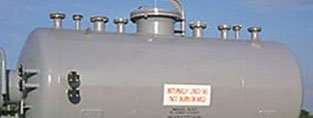
- (03) 5909 8218
- enquiry@fusionweld.com.au
Qualities of a Good Carbon Dioxide Storage Tank
July 28, 2013

Colourless and odourless, we know carbon dioxide as a greenhouse gas and a key part of our own respiratory cycle. It's also used in numerous commercial and industrial applications. Check out CO2 lasers, polymer synthesis, and beverage carbonation for more data on the countless usage domains. A properly designed carbon dioxide storage tank is therefore and essential part of these applications, as the gas has to be amassed before it can be used.
Alloy-Strengthened Shells
Carbon dioxide won't catch fire, but the gas does possess other dangerous attributes. It's invisible, so leaks aren't always obvious. CO2 is also stored at extremely low temperatures, so a carbon steel shell is recommended. This alloy is approved for use in cryogenic facilities, so it can capably handle pressurized carbon dioxide, even when the temperature dips very low. Brittle materials need not apply, in this case, for the combination of external heat and internal pressure will cause product vaporization. The strength of the weld seams and the quality of the rolled metal protects against rupture events.
When is an Inert Gas Hazardous?
Environmental factors challenge the containment facility, even though we're referring to a naturally occurring atmospheric gas. Carbonic acid, for example, is a popular part of the soft drinks industry, but it has no place in a storage yard. But this is exactly what happens when carbon dioxide is exposed to a humid environment. The liquid acid is weak, of course, but it will corrode metal fixtures over time.
Low-Temp Hazard Avoidance Strategies
When low temperatures are employed, a new set of hazardous variables come to light. Explosive risks are still present because pressurized fluids are contained, but there's no flammable content to worry about. Instead, the design incorporates materials that insulate against subzero temperatures. The carbon steel shell is typically coated in a urethane insulant, a polyurethane foam that keeps the CO2 medium below minus twenty-nine degrees celsius. Additionally, low-temperature extremes partner with up to 2150 kPa of pressurized vapour, so the tanks must be equipped with pressure protecting aids, including relief valves and pressure gauges.
It's true that a carbon dioxide storage tank doesn't act as a barrier against some combustible or toxic chemical compound, but the gas is stored at great pressure and it does change state several times, from liquid to solid. That same cold environment produces dry ice, a cryonics material that can cause frostbite. The vessel must deal with both the pressure and the freezing cold, which means a strong carbon steel is required if material brittleness is to be eliminated.
Contact Details
Fusion - Weld Engineering Pty Ltd
ABN 98 068 987619
1865 Frankston Flinders Road,
Hastings, VIC 3915
Ph: (03) 5909 8218
Optimized by NetwizardSEO.com.au
Recent Posts
- Heat Exchanger Maintenance in Melbourne: Minimising Risk in Power Generation Facilities
- Compressed Hydrogen Storage Vessels: Material Selection, Design & Australian Standards
- Welding QA/QC in Oil & Gas Pressure Vessel Fabrication – Ensuring Code Compliance
- AS1210 vs ASME VIII Pressure Vessel Code: Key Differences for Australian Projects
- Mitigating Hydrogen-Induced Cracking in Pressure Vessels: Engineering and Material Strategies
- Storage Tank Solutions Australia: Field-Erected, Prefabricated & Self-Bunded Explained
- Reducing Environmental Risks: Self-Bunded Tanks in Australian Oil & Gas Operations
- Precision in Production: How Pressure Vessels Are Manufactured for Industrial Safety
- Shell & Tube Heat Exchangers: Improve Thermal Control & Energy Recovery in Petrochemical & Pharmaceutical Plants
- In-Service Inspection for Compressed Air Receivers for Power Plant Shutdown Prevention
- Power Plant Pipe Spooling Fabrication – Get Rapid, Code-Compliant Spools Ready for Installation
- Field Erected Tanks: Safe, Reliable On-Site Fuel Storage Solutions in Australia
Posts 2026
- Heat Exchanger Maintenance in Melbourne: Minimising Risk in Power Generation Facilities
- View all articles…
Posts 2025
- Compressed Hydrogen Storage Vessels: Material Selection, Design & Australian Standards
- Welding QA/QC in Oil & Gas Pressure Vessel Fabrication – Ensuring Code Compliance
- View all articles…
Posts 2024
- Large Process Vessels: Optimising the Design for Maximum Efficiency [2025]
- Pressure Equipment Management System Installation: Detect Equipment Faults Early
- View all articles…
Posts 2023
- Pressure Piping System Inspection: A Gift of Safety for the Holidays
- Deaerator Inspections by Fusion-Weld Engineering and How They Reduce System Downtime
- View all articles…
Posts 2022
- How Fusion Weld Keeps Up With AS-NZS ISO 9001:2008 Standard
- Boiler Equipment Safety Inspection During the Summer Season
- View all articles…
Posts 2021
- Avoid These Factors and Practices that Contribute to Sealing Damage in Pressure Vessels
- Do's And Don'ts Of Industrial Boiler Inspection And Maintenance From Fusion-Weld
- View all articles…
Posts 2020
- What are the Risks and Hazards Involved in Pressure Vessel Equipment?
- How to Know if Your Pressure Equipment Needs Repair or Replacement?
- View all articles…
Posts 2019
- Factors that Contribute to Pressure Vessel Failure
- Pressure Vessel Regulations in Australia: What are the Mandatory Requirements?
- View all articles…
Posts 2018
- Pros and Cons of Spherical vs. Cylindrical Pressure Vessels
- What are the Different Hazard Levels in Pressure Vessels?
- View all articles…
Posts 2017
- Transportable Pressure Vessels: The Importance of Inspection and Safety Checks
- Fracture Mechanics and Stress Analysis of Cracks in Pressure Vessels
- View all articles…
Posts 2016
Posts 2015
- What Are Deaerators & Feedwater Vessels?
- Precautions and Safety for Compressed Air Receiver Vessels
- View all articles…
Posts 2014
- Demonstrating In-process Inspection Procedures
- Static Grounding Practices and Standards
- View all articles…